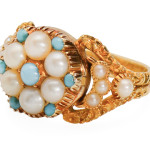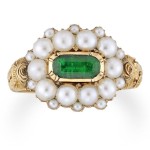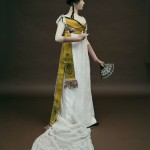Galleries
Untitled
“The Three Graces has the honor to present this ring as one of the finer examples of its type and condition. Hailing from the earlier 19th century in the romantic portion of the Georgian period, it is exceptional in every regard.
More ornate than the typical cluster ring of the time, the top is hinged and opens to reveal a secret glass covered locket compartment. Hand-engraved to the obverse of the locket top on the interior of the shank is “from Hugh Clunes, to his sister, Margaret”. Exceedingly fine, the top is modeled in a vision of a flower head using natural half saltwater seed pearls and natural half Persian turquoise with a crimped collet perimeter with the central turquoise in a pinched bezel setting.
A trio of half seed pearls set in individual pinched collets forms a “bridge” across the wider section of each split shoulder along with a separate pearl closer to the double shank. Throughout the surface of the 15k yellow gold shank and shoulders you find that characteristic floral texture and pattern for which the English are best known.
Please note how the bifurcated shoulders segue into the double banded shank. Hand engraved to the interior of the shank is the Latin phrase “Pignus Amicitiae” which translates as a pledge of our friendship or a token of our alliance. In all, the period 15k yellow gold ring is set with fourteen (14) natural half seed pearls and seven (7) natural half turquoise cabochons.”
Untitled
Sword Pistol
- Dated: circa 1820
- Measurements: overall length 36 inches (91.4cm); blade length 30 1/4 inch (76.8cm)
Having the blade of a rapier from the Carlos IV era, this weapon has a percussion pistol frame marked “BALT”. It comes with a stylised animal head hammer and an elongated trigger. Features fluted wood grips and a pommel designed so the user can extend the hand at a certain degree for shooting.
Untitled
-Various Dresses from 1800 to 1820-
Untitled
get to know me meme: 1/5 favorite movies – maurice (1987)
“I’m an unspeakable of the Oscar Wilde sort.”
Untitled
Wlliam Hogarth
Strolling Actresses Dressing in a Barn
England (1738)
Etching/Engaving, 16 3/4 x 21 1/4 in.
By the middle of the 18th century there were between 10-15,000 black people living in London. The development of the slave trade from the mid 17th century brought many more African people to the UK. However not all black people at this time were slaves.
Hogarth’s prints of life in London feature black performers in pageants as well as black actresses and dressers. The picture ‘Strolling Actresses in a Barn’ shows a group of touring actresses in various states of undress as they prepare for that evening’s performance of ‘The Devil to Pay’ at the George Inn in South London.
Men at this time could pay to peek at the actresses changing. The figure in the centre of the image looking out at the viewer appears to be performing for us, and casts us as one of these Peeping Toms.
The print also shows the presence of black people in
London at the time: to the right a black woman is darning the stockings of an actress; and on the left, a black actress dressed as Aurora (the goddess of dawn) picks lice off the collar of a kneeling colleague whose costume has a mermaid’s tail.The engraving shows a seedy, disordered side to a play filled with magic and goddesses, but also illustrates the normality of a black presence in English working class communities.
Untitled
Spring-Loaded Dick in a Box
19th century
Christie’s
Your dashboard has now been greatly improved by the presence of the phrase “Spring-Loaded Dick in a Box.”
…
I want one.







